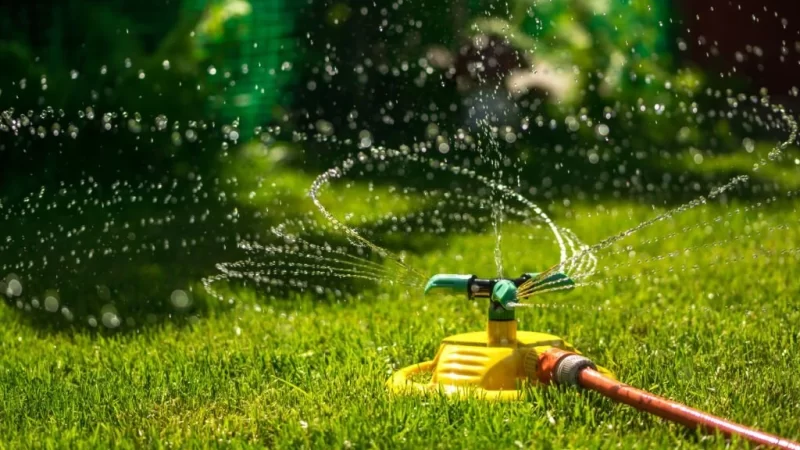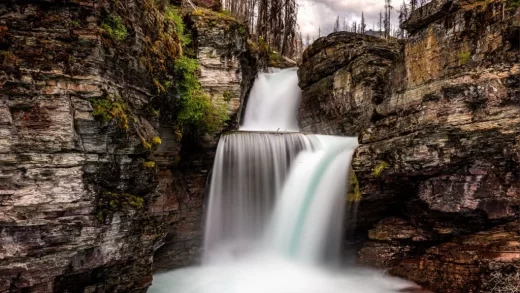Best Time To Water Grass | 10 Amazing Things To Know

Best time to water grass: Learn when—and exactly how much—to water your lawn so that you can take care of it without squandering a valuable resource.
Getting the greenest, most immaculate grass in the neighborhood is no longer the only consideration when determining whether to water your lawn (though it remains a factor).
Although drought has affected many communities recently, it’s more crucial than ever to follow common sense recommendations while watering a lawn.
By doing it properly, you may save resources and avoid trouble with your homeowner’s association and perhaps your city.
Using prudent watering techniques may also help you avoid penalties in places where HOAs and local governments impose severe regulations.
The Optimum Time To Water Grass Is First Thing In The Morning
The best water absorption is achieved by watering grass throughout the day, ideally around daybreak when everything is cooler.
If you water your lawn at night or later in the day, especially if it’s sunny, warm, and windy, your grass and other plants will lose valuable moisture due to the wind and heat of the sun and soil.
You waste less water since it is less prone to evaporate in the morning’s lower light and temperature.
The water has a better chance of reaching the roots and being properly used if the task is completed before daybreak. So adjust those sprinklers as necessary.
To Encourage Germination, Water Freshly Planted Grass Seed Twice Daily
The ideal temperature range for grass seed growth is between 59 and 69 degrees Fahrenheit.
Grass seeds also need regular hydration. They may germinate under these circumstances.
Germination might take anywhere between 5 and 30 days, depending on the kind of grass seed sowed.
Watering grass seed should aim to keep the top 1.5 inches of soil wet but not always damp. The proper quantity of water is essential for the sprouts to establish roots.
Too much water may pool or run off and wash away the seed, causing clumps or bare places, while not enough water dries up the sprout and kills it.
Generally speaking, water grass seed twice a day for 5 to 10 minutes each time, first in the morning and once in the afternoon after the hottest portion of the day has gone.
Recommended: Best Time To Visit Hawaii | Cheap, Good & Worst Times Info
It’s Crucial To Take Your Water Use Into Account
Setting your sprinkler or irrigation system to the maximum setting and dousing the area as fast as possible may seem prudent, but doing so risks runoff.
This wastes water and deprives the grass of adequate absorption. Therefore pay attention to your lawn’s edge to make sure you’re not actually letting valuable water go down the drain when it might be promoting the growth of your grass.
The Amount Of Water That Grasses Require Depends On Their Growing Season
In chilly, northern regions or when warmer conditions are not in full swing, cool-season grasses are often grown.
With their greatest growth seasons occurring in the spring and autumn, these grasses begin to develop when the soil temperature reaches between 40 and 60 degrees Fahrenheit.
Cool-season grasses normally need around 1 inch of water per week when watering a lawn. Watering three times per week at properly spaced periods will do this.
Southern, warm temperatures are the natural habitat of warm-season grasses. As the soil temperature reaches between 60 and 65 degrees Fahrenheit, these kinds of grasses begin to develop, reaching their optimum growth season in the summer.
Warm-season grasses have deep roots as a consequence of their heat tolerance.
Warm-weather grasses should only get 1/2 to 1 inch of water per week when watering a lawn.
Some kinds of grasses simply need one or two weekly waterings. Generally speaking, one inch of Water should be added each week.
Measure your output and wait approximately 3 days between each watering session to allow it a chance to breathe. If you water your grass more than an inch a week, it may drown, losing oxygen and dying.
Place a few coffee cups around your yard and test the sprinkler system to see how long it takes to fill each one to the 13- or 12-inch mark. This will guarantee that you’re hitting the target.
Set the system to run for that length of time every three days or so. Daily watering is virtually never sufficient, and once per week is seldom enough. Hence, aim towards the center and watch your grass grow.
One To Three Times Each Week, Water Your Established Grass
Depending on whether you have warm-season or cool-season grasses, you need to water your lawn at certain times.
Warm-season grasses don’t need to be watered as often because of their vast root systems, which penetrate deeply into the ground. These grasses need to be watered as little as possible.
However, since their roots are shallow, cool-season grasses need moisture all the time. The roots may get the nutrients they need to flourish by being watered up to three times each week.
Look Out For Any Dryness
Lack of moisture will probably cause grass that is yellow or curled up at the top to become unhealthy.
The same is true of a lawn where your footsteps remain visible after you’ve made a path through it and the grass blades won’t stand back up.
Adjust your lawn watering plan to start earlier in the day and allow for slightly longer sessions if you see these indicators of dryness. You may also fine-tune your watering days to happen a little more regularly.
Recommended: Best Time To Visit Costa Rica | 5 Reasons, Seasons & Budget Guide
Be Cautious About Overwatering As Well
You know you’re watering your lawn too much if the ground feels like a sponge and sinks in as you walk on it or if you run your fingers over the grass blades and feel a layer of the additional plant covering the dirt.
Nonetheless, don’t change your frequency suddenly. To prevent the shock of the change from further damaging your grass, give yourself a few weeks to gradually adapt your lawn watering plan.
Trying To Reduce Your Water Usage? Think About Natural Landscaping OR Xeriscaping
Xeriscaping is the practice of landscaping that needs no or little watering, often replacing grass with sand, pebbles, mulch, or rock gardens.
Native landscaping uses grasses and plants that grow naturally with the average amount of rainfall in the area, minimizing or completely eliminating the need for additional watering.
You may also look for natural grasses in your region and establish a small patch for kids and dogs to play in.
Some homeowners opt to mix xeriscaping with native plants for a lovely, eco-friendly landscape that requires minimal maintenance.
Both xeriscaping and native plants are appealing and practical solutions to reduce your water cost.
Also, you won’t have to worry about whether to water grass in the heat of the summer or the cold of the winter since your landscape will be well-suited to the local climate all year long. Regardless of your strategy, success with your outside area!
Conclusion
Early in the morning is the optimum time to water grass since it provides the water time to soak before the heat of the day and helps supply the nutrients and oxygen the grass needs to grow.
Learn more about your lawn and the sort of grass you have to provide it with the attention it needs by doing research.
You may calculate the amount of water you need by understanding the requirements of your grass or grass seeds.
Water sensibly to help your grass flourish and to better manage your water supplies. Avoid both underwatering, which may cause dried-out areas on your lawn, and overwatering, which can push vital nutrients out of the roots reach.
Your grass will improve if the appropriate quantity of water is applied at the ideal time of day.
(FAQs)
When to Water Grass at its Best
Your lawn will benefit much from learning when to run sprinklers in your yard and putting that knowledge into practice.
Here are some often-asked questions and their respective responses about the optimum time to water grass in order to better understand how to encourage your grass to develop and how to water it correctly.
When watering grass in the sun, does it get burned?
t’s a popular myth that watering grass in the heat would burn the grass underneath it because the water droplets behave like magnifying glasses.
Your grass develops dry areas when it doesn’t get enough water. The optimum time to water grass is early in the morning since watering during the heat of the day causes the water to evaporate more quickly and your lawn doesn’t get as much moisture as you believe it does.
Should I water the grass after I mow it?
Only if you see that your lawn is in desperate need of moisture after mowing should you water it.
Water your lawn after mowing if your watering schedule in the morning matches with when you usually mow. If you like to mow your lawn during the day, wait until the morning before watering it.
How often should grass seed be watered?
For grass seed to germinate, it must be watered at least twice daily. Depending on the kind of grass, this procedure might take anywhere from 5 and 30 days, so pay attention to the supplier’s recommendations.
To aid in the germination and sprouting of the seeds into the grass, it is important to maintain the soil’s surface continually wet.
How far down do grassroots extend?
The kind of grass you are using will determine how deep the roots go. Numerous grassroots may be discovered only a few inches below the surface.
Grassroots may extend up to three feet deep in established lawns that have had time to develop and establish themselves.
What time of day is ideal for watering grass seeds?
Early in the day and late in the day after the warmest portion of the day has gone are the optimum times to water grass seed.
You may need to water more often in warmer or drier regions. For grass seed to germinate, the top 112 inches of soil must be consistently wet.














